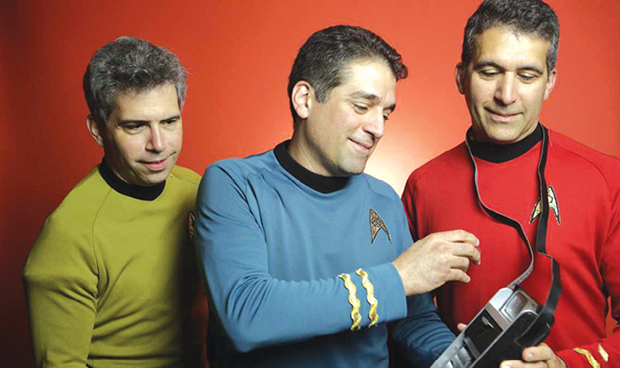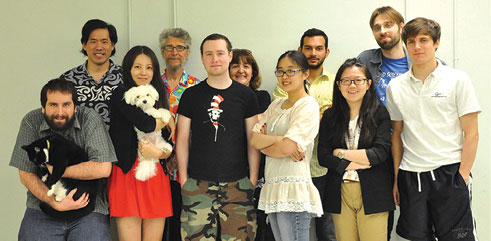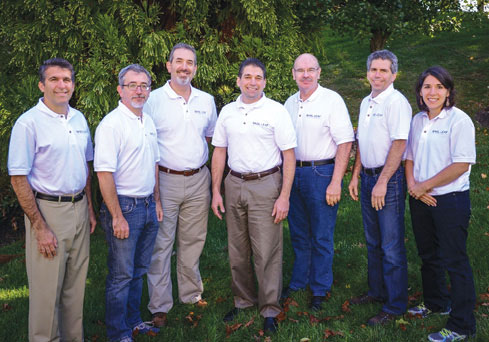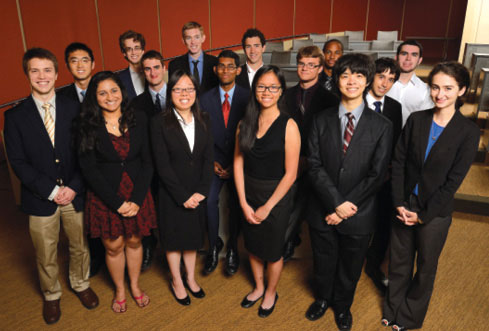
Final Frontier Medical Devices. Image courtesy of XPRIZE Foundation.
Latest News
May 1, 2015
Emergency room visits in the United States are on the rise — up 34% between 1995 and 2010, according to the Centers for Disease Control and Prevention — even as the number of emergency rooms decrease (down 11% over the same period). It all adds up to overcrowded ERs and lower-quality care for patients as they wait longer to see a doctor and get tests that may or may not be needed.
Against this backdrop, the $10 million Qualcomm Tricorder XPRIZE seeks to foster the development of devices that would put the power to diagnose medical conditions into the hands of consumers, giving them more flexibility and faster access to the information needed to stay healthy.
The goal of the contest is a demonstration of not only what is going to be practical in the future, but also what can be learned “so that we refine these tools and processes so that it’s scalable,” says Qualcomm Tricorder XPRIZE Senior Director Grant Campany. The XPRIZE Foundation wants to jumpstart the development of a new class of products that give ordinary people unprecedented control over their healthcare.
Inspired by the 23rd century tricorder of the “Star Trek” universe, the prize offers $7 million, $2 million and $1 million to first-, second- and third-place teams, respectively. Winning teams will each have to create an easy-to-use system that weighs under five lbs. and can accurately diagnose a set of 13 core conditions (including an absence of conditions), along with three of 10 additional “elective” conditions. They will also have to measure and autonomously evaluate five vital signs, including heart and respiration rate and temperature.
Neatness Counts
Along with accuracy, developing a user-friendly experience is vital to winning the prize. In fact, evaluations of accuracy and usability will be equally weighted by judges in determining the winners — 45% of the overall consideration for each factor. The remaining 10% considered for determining awards will be given to the teams’ explanations of how they intend to develop their entries into viable products.
In August 2014, a team of 22 independent judges helped pare down around 40 teams that had registered to compete to 10 finalists based on extensive documentation outlining their approaches. Now it’s up to those 10 teams, which hail from across North America and Europe, as well from India and Taiwan, to produce working prototypes — at least 30 per team — for evaluation by patients who have the conditions to be diagnosed. The prototypes are due in the XPRIZE offices this month. Researchers at UC San Diego’s Clinical and Translational Research Institute (CTRI) will oversee the testing that will take place at CTRI as well as in the patients’ homes over a six-month period from June until December. Winners will be announced in Los Angeles in January 2016 — the 50th anniversary year of the “Star Trek” TV series debut.
“He’s not dead, Jim.”
The competition looks almost tailor-made for team DNA Medicine Institute (DMI). DMI is headed by Eugene Chan, who also serves as CEO of the Cambridge, MA-based startup. Chan’s experience as a working physician inspired him to found DMI with the goal of developing user-friendly medical devices. “The ability to be able to get diagnostic information as fast as possible started with seeing patients in the middle of the night,” says Chan. In the absence of good, fast information, he says, “bad things happened.”
 The DNA Medical Institute (DMI) is working on technology that can diagnose a patient via blood
The DNA Medical Institute (DMI) is working on technology that can diagnose a patient via blood
sample in an all-in-one unit. Image courtesy of team DMI.
Instead of having to rely on an outside lab that may not be open at a critical time, Chan longed for a device that could do the work of the lab, but would fit in his pocket. NASA became DMI’s first client as it pursued its own quest to develop medical technologies for long-duration space missions.
DMI’s approach to winning the prize hinges on blood analysis. After pricking themselves with a lancet, a patient can squeeze a drop of blood into a small receptacle, which then gets loaded into a portable diagnostic device, dubbed the rHEALTH X1. There, the blood mixes with microscopic test strips and other reagents. Illuminated with laser light, the reagents reflect the light differently depending on what’s in the blood. An app running on a tablet docked with the machine runs an analysis and displays the results.
Chan says his team’s small size is an asset. “Small is absolutely better,” he says. “Right now, we’ve got 20 people working on this.” That size, says Chan, fosters highly efficient communication. The team designs its prototype in Dassault Systèmes’ SolidWorks and creates them with a 3D Systems V-Flash 3D printer. For designing printed circuit boards (PCBs), the team uses Altium Designer.
The Final Frontier of Medicine
Not every team has the backing of an established company. Basil Harris, a working emergency room physician, heads team Final Frontier. For Final Frontier, the competition is a family affair. Harris’ brother, George, serves as lead programmer; their sister, Julia, works with friend Phil Charron on user experience design; while electrical engineer and physician brother Gus does signal processing for the project using MathWorks’ MATLAB software. Ed Hepler designs the custom-made integrated circuits for the Bluetooth-enabled devices that comprise their entry. He designs the circuits using the open-source TinyCAD software package. George’s daughter, Amanda, does graphic design for the team, and Andy Singer manages their finances. The team designs the devices themselves in the BlenderCAD open-source design package and creates prototypes using MakerBot Replicator 3D printers.
 Final Frontier Medical Devices is headed by Basil Harris, an emergency room physician who uses his real-life knowledge to create algorithms and capabilities for the team’s device. Image courtesy of Russell Karten, MD.
Final Frontier Medical Devices is headed by Basil Harris, an emergency room physician who uses his real-life knowledge to create algorithms and capabilities for the team’s device. Image courtesy of Russell Karten, MD.For Basil Harris, the challenge posed by the competition comes down to synthesizing his knowledge of emergency medicine, creating the right algorithms to codify it, and then spitting it back out in response to input from a patient. As far as he’s concerned, data-collection devices like heart monitors are secondary in importance to the algorithms. “They’re actually good in a number of categories,” he says of the algorithms, which run on an iPad app. “They’re not perfect across the board. But that’s even without taking the objective data.”
In other words, the artificial intelligence being developed by team Final Frontier can diagnose some conditions on its own simply by asking the right questions. The team has been able to fine-tune the system by conducting trials in the best possible environment — the ER itself.
With the team (including a handful of other specialists) spread out from Boston to Tennessee, the group places a premium on online collaboration. They also strive to make the best use of the face-to-face time they do have — typically in Basil’s house in Pennsylvania, where MakerBot 3D printers churn out prototypes.
Team Final Frontier’s design includes two electronics-laden patches to be placed on the patient’s chest for heart readings, a thermometer, a spirometer for measuring respiratory flow, and a self-contained disposable urine tester, which is to be dunked in a sample provided by the patient.
Basil says he’s amazed at what can be accomplished by a self-funded team of amateurs working part time. “I would encourage anybody to try to make stuff,” he says. “It’s the golden age of creation.”
Nice Work if You Can Get It
The competition has also captured the interest of students and academic professionals. Biomedical engineering student Tatiana Rypinski heads a team of fellow undergraduates at Johns Hopkins University in Baltimore called Aezon. In addition to students, Rypinski has recruited faculty mentors as well as outside corporate partners. For designing its devices, the team uses SolidWorks and 3D prints prototypes on a MakerBot Replicator and a Stratasys Dimension BST 1200es. The team designs PCBs in Novarm DipTrace.
 Team Aezon is made up of students and faculty from Johns Hopkins University. Image courtesy of Will Kirk.
Team Aezon is made up of students and faculty from Johns Hopkins University. Image courtesy of Will Kirk.Rypinsk says the key to the success of team Aezon lies in the group’s organization. Specialized teams within the larger group each work on a specific disease or piece of the software and hardware puzzle — the smartphone app at the heart of the system, the wearable vital signs monitoring device, or the lab box that processes biosamples.
Rypinski’s biggest takeaway: “Don’t be afraid to reach out for help if you have a great idea. You have nothing to lose by reaching out and pitching your project and trying to move it forward.”
The range of approaches taken to win the Qualcomm Tricorder XPRIZE point to a major benefit of incentive prizes for solving technical challenges: they call forth a diversity of ideas that would be difficult to bring together by any other means. That’s a boon to the XPRIZE Foundation, as well as, the foundation hopes, to future consumers. “Everything that we do is geared toward not only solving problems but building markets,” says Campany. Even the seven finalists who don’t win cash prizes should benefit. “You get an independent, objective evaluation of your platform relative to others,” he says. And that feedback could enable teams that don’t win the prize competition to win in the marketplace.
For More Info
Subscribe to our FREE magazine, FREE email newsletters or both!
Latest News
About the Author
Michael Belfiore’s book The Department of Mad Scientists is the first to go behind the scenes at DARPA, the government agency that gave us the Internet. He writes about disruptive innovation for a variety of publications. Reach him via michaelbelfiore.com.
Follow DE





